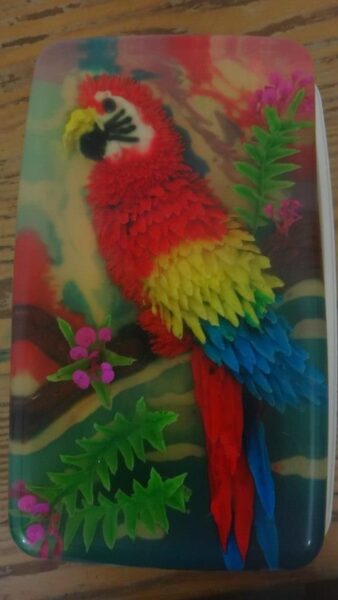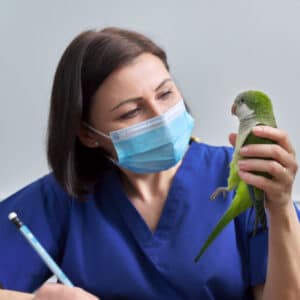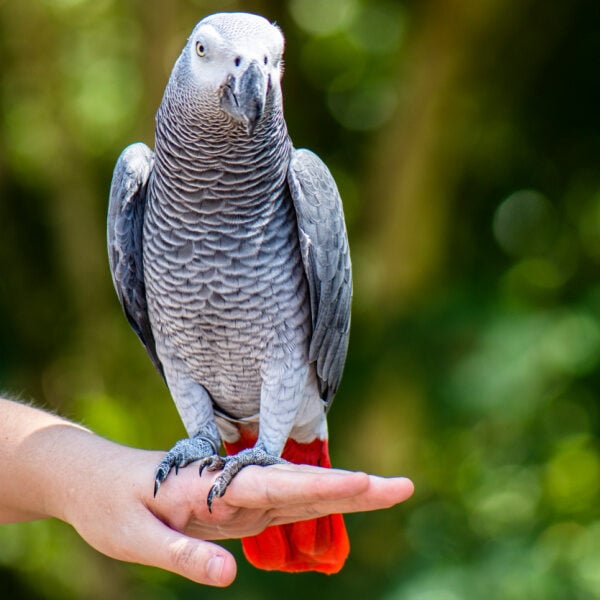Last Updated on by Mitch Rezman
Popcorn update
Thursday (6/9/16) she was very low energy and didn’t leave her cage after opening the door. The very first thing I do every morning is replace her water with freshwater after scrubbing out her food dish to avoid bacteria.
We are now introducing a milk thistle liver detox into her water. I place the eight drops in the bottom of a dry dish and add a couple of ounces of water to make sure the milk thistle solution gets dissolved. Then I add half an ice cube to keep the water fresh until the mid-day replacement. (It gets replaced again at birdie bedtime).
Do you know how much water your bird drinks? Do you know how to measure it? I use the counting method. Popcorn normally takes 2 to 3 beak fulls of water every morning. Today she took nine triple her normal intake.
She’s panting and her abdomen is a bit swollen so we ran her to the vet. She’s losing weight down to 96 g which is very light for her.
She sitting on a hot water bottle in her well-heated cage with a light off and I’m going to watch her through the night at some point possibly having to make the decision to put her down.
It sounds cruel but I’m a huge quality-of-life guy. Today apparently in veterinary medicine hospice has become a national trend.
I’ve hospiced a human – because I had to. I will not allow a pet to suffer as long as I know we’ve done everything we possibly could to keep it healthy.
Agree or disagree – we all have to do what is right for ourselves.
I put her down (6/9/16) 12:58 cst – she’ll be buried next to Sunshine our Ringneck who passed mothers day 2007 under 3 large oak trees next to our new wild bird feeding station.
From Jeanette
Hi
Is it safe for my Blue Front Amazon to share my fruit, yogurt, seed, and granola breakfast if I put collagen hydrolysate on it?
So here’s the thing – Jeanette
That depends – how do we know your Amazon parrot is lacking in collagen hysolysate?
Although collagen fibers are found in a bird’s skin
From a paper named Avian Integument produced by Eastern Kentucky University
For many birds, skin coloration is the result of optical interactions with biological nanostructures or, in other words, the microscopic structure of skin. Such structural colors occur in the skin, bill (ramphotheca), legs and feet (podotheca) in about 129 avian genera in 50 families from 16 avian orders. Structurally colored skin is present in more than 250 bird species, or about 2.5% of all bird species.
Examination of the color, anatomy, and nanostructure of structurally colored skin, rhamphotheca (beak), and podotheca (the horny integument covering unfeathered portions of the legs and toes of most birds) (from several different species of birds indicates that color, including ultraviolet, dark blue, light blue, green and yellow hues, is produced by coherent scattering (i.e., constructive interference) of light from arrays of parallel collagen fibers in the skin (dermis) . Scattering, in this case, simply means that light deviates from a straight path.
That’s natural collagen but based upon what the man-made substance is according to Bob Busscher president of Great Lakes Gelatin,
they carefully source grass-fed beef hides for the raw material for their bovine products. The split hides (under the hair where the collagen lies) are put into an alkaline solution and held for a number of days where the material is broken down…………………..

Next, its acid back washed and pumped into cooking kettles which separate tallow, skin, and collagen.
Collagen hydrolysate: The collagen is stored in a holding tank at a higher temperature to reduce the molecular weight cleaving the amino acid bonds. This process is called hydrolysis.
Important Note: Remember not to get too carried away with gelatin. Adding too much too quickly can cause digestive issues: bloating, loss of appetite, and stomach ache are just a few side effects. Learn more @ http://www.thehealthyhomeeconomist.com/gelatin-and-collagen-hydrolysate-whats-the-difference/
Personally, I see no reason to introduce manmade collagen hydrolysate to any bird especially after reading about what it’s made from.
That said anyone who knows me knows that I test for everything. If you feel your bird has deficiencies my advice would be to seek an avian veterinarian and have a complete blood panel performed to see what nutrients your bird may be exiguous [ig-zig-yoo-uh s] in – perhaps even some collagen.
Mitchr
Susi N J · Friends with Benny B
commented on a Facebook post – on my personal timeline in response to this video
“Becurse you teach him. Kills the bird giving it human food. So please stop. Give it a favorite snack instead. Be consistent”
Susi
1) that statement is a bit over the top – Goldenfeast bird food is 100% human grade food
2) she has cancer and has had more blood work-ups than I care to count – the data on the blood work ups we did for 9 consecutive weeks dispute her health is is any way compromised by her diet which is probably 10% snatched from our dinner plates.
3) the only thing we have added to her diet since the diagnosis is way more millet than she’s ever gotten (like giving sick kids milkshakes)
4) Vets and many experts today like Patrica Sund recommend chops for birds made entirely of human food – when you get a moment please check out my blog
April Emery
Hi guys
You know I follow and love your blog and I want to offer a hint about pellets.
I have two young parakeets that love their seeds but I have been determined to get them to at least add pellets to that diet even though after two years I’m pretty convinced that they will never give up all seed.
They eat Harrison’s Adult Lifetime Super Fine which I had chosen after lots of research. And yes, the SUPER fine is very hard to find! They will eat it out of my hand like a treat so I know they recognize it as food and like it.
But mixed in with their seed, I still feel they mostly eat around it! But here’s my hint: they love it crushed to a powder! Once when I could only get the “fine”, which is too big for parakeets, I had to break it up for them and they liked to eat the powdery bits best.
So in addition to always putting the superfine in with their seed, at least once a day I offer them the powdered form, in our case in a little handheld shell. It’s “together time” well spent and they eat so much! I just put a teaspoonful on a small plate and crush it with the bottom of a glass.
This might be a good way to introduce pellets as food to the average bird which is usually not the foodie that Popcorn is. She is exceptional that she ate it right away! (You know we are all holding good thoughts for her.) And you might want to try powder for her if she gets finicky.
But my girls will also only eat Nutriberries broken apart in my hand – otherwise, they are just balls to drop or throw. They can manage Avicakes in the forager but that is a seldom treat
I just don’t know about all that molasses (just sugar) and they pick out the seeds and drop the pellets anyway, being too smart for Avicakes. They’re too smart in general – we just try to keep up!
April your comments
are invaluable! We will pass this content on to everyone who enjoys our Birdie Brunch.
Your Harrison’s method is very efficient – Lafebers will tell you that roughly 50% of their Nutriberries/Avicakes is the anticipated waste factor.
mitchr
Written and Approved by the Windy City Parrot Content Team
Author Profile
Latest entries
 The Traveling BirdJune 26, 2025Can You Name 5 Parrot Species That Are Living Wild in the USA?
The Traveling BirdJune 26, 2025Can You Name 5 Parrot Species That Are Living Wild in the USA? Bird BehaviorJune 26, 2025How is it Parrots Are Problem Solvers Social Animals and Even Use Tools?
Bird BehaviorJune 26, 2025How is it Parrots Are Problem Solvers Social Animals and Even Use Tools? Bird & Parrot AnatomyJune 25, 2025How a Tiny Chemical Modification Makes Parrots Nature’s Living Paintings
Bird & Parrot AnatomyJune 25, 2025How a Tiny Chemical Modification Makes Parrots Nature’s Living Paintings PigeonsJune 20, 2025How Do Parrots Thrive in Cities Outside Their Native Habitats?
PigeonsJune 20, 2025How Do Parrots Thrive in Cities Outside Their Native Habitats?




